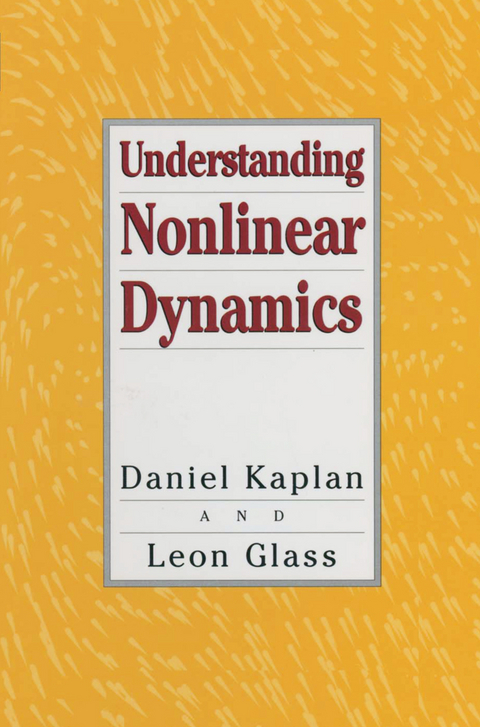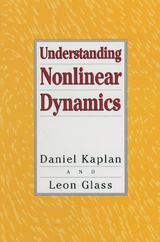Understanding Nonlinear Dynamics
Springer-Verlag New York Inc.
978-0-387-94440-1 (ISBN)
1 Finite-Difference Equations.- 1.1 A Mythical Field.- 1.2 The Linear Finite-Difference Equation.- 1.3 Methods of Iteration.- 1.4 Nonlinear Finite-Difference Equations.- 1.5 Steady States and Their Stability.- 1.6 Cycles and Their Stability.- 1.7 Chaos.- 1.8 Quasiperiodicity.- 2 Boolean Networks and Cellular Automata.- 2.1 Elements and Networks.- 2.2 Boolean Variables, Functions, and Networks.- 2.3 Boolean Functions and Biochemistry.- 2.4 Random Boolean Networks.- 2.5 Cellular Automata.- 2.6 Advanced Topic: Evolution and Computation.- 3 Self-Similarity and Fractal Geometry.- 3.1 Describing a Tree.- 3.2 Fractals.- 3.3 Dimension.- 3.4 Statistical Self-Similarity.- 3.5 Fractals and Dynamics.- 4 One-Dimensional Differential Equations.- 4.1 Basic Definitions.- 4.2 Growth and Decay.- 4.3 Multiple Fixed Points.- 4.4 Geometrical Analysis of One-Dimensional Nonlinear Ordinary Differential Equations.- 4.5 Algebraic Analysis of Fixed Points.- 4.6 Differential Equations versus Finite-Difference Equations.- 4.7 Differential Equations with Inputs.- 4.8 Advanced Topic: Time Delays and Chaos.- 5 Two-Dimensional Differential Equations.- 5.1 The Harmonic Oscillator.- 5.2 Solutions, Trajectories, and Flows.- 5.3 The Two-Dimensional Linear Ordinary Differential Equation.- 5.4 Coupled First-Order Linear Equations.- 5.5 The Phase Plane.- 5.6 Local Stability Analysis of Two-Dimensional, Nonlinear Differential Equations.- 5.7 Limit Cycles and the van der Pol Oscillator.- 5.8 Finding Solutions to Nonlinear Differential Equations.- 5.9 Advanced Topic: Dynamics in Three or More Dimensions.- 5.10 Advanced Topic: Poincaré Index Theorem.- 6 Time-Series Analysis.- 6.1 Starting with Data.- 6.2 Dynamics, Measurements, and Noise.- 6.3 The Mean and Standard Deviation.- 6.4 Linear Correlations.- 6.5Power Spectrum Analysis.- 6.6 Nonlinear Dynamics and Data Analysis.- 6.7 Characterizing Chaos.- 6.8 Detecting Chaos and Nonlinearity.- 6.9 Algorithms and Answers.- Appendix A A Multi-Functional Appendix.- A.1 The Straight Line.- A.2 The Quadratic Function.- A.3 The Cubic and Higher-Order Polynomials.- A.4 The Exponential Function.- A.5 Sigmoidal Functions.- A.6 The Sine and Cosine Functions.- A.7 The Gaussian (or “Normal”) Distribution.- A.8 The Ellipse.- A.9 The Hyperbola.- Exercises.- Appendix B A Note on Computer Notation.- Solutions to Selected Exercises.
| Erscheint lt. Verlag | 19.12.1997 |
|---|---|
| Reihe/Serie | Textbooks in Mathematical Sciences |
| Zusatzinfo | XX, 420 p. |
| Verlagsort | New York, NY |
| Sprache | englisch |
| Maße | 155 x 235 mm |
| Themenwelt | Informatik ► Weitere Themen ► Bioinformatik |
| Mathematik / Informatik ► Mathematik ► Analysis | |
| Mathematik / Informatik ► Mathematik ► Angewandte Mathematik | |
| Mathematik / Informatik ► Mathematik ► Geometrie / Topologie | |
| ISBN-10 | 0-387-94440-0 / 0387944400 |
| ISBN-13 | 978-0-387-94440-1 / 9780387944401 |
| Zustand | Neuware |
| Haben Sie eine Frage zum Produkt? |
aus dem Bereich




